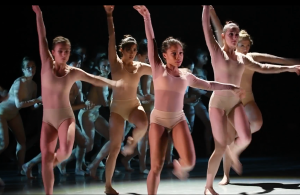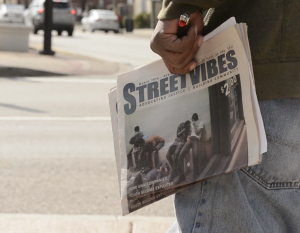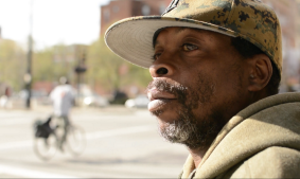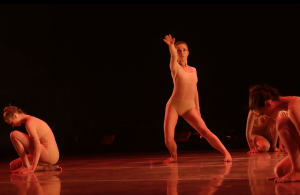UC Student Videographers Receive Regional Emmy Awards
Recognitions are first of their type for Department of Journalism.
Date: 09/07/2017 3:00:00 PM
By: Jonathan Goolsby
Contact: Julie Campbell-Holmes
Phone: (513) 509-1114
Photos: Video stills by Bob Jonason
CINCINNATI, Oh. — For the first time, University of Cincinnati (UC) student journalists have received regional Emmy® Awards from the Ohio Valley Chapter of the National Academy of Television Arts & Sciences (NATAS).

Screen shot from Shae Comb's Day of Wakening video documentary.
Rising senior Shae Combs’ micro-documentary, Day of Wakening, which examined the interface of creativity and self-awareness through the lens of dance performance, won the Arts and Entertainment / Cultural Affairs category.
Recent graduate Gretchen Semancik’s Streetvibes, which movingly profiled a vendor for the Greater Cincinnati Coalition for the Homeless’ alternative newspaper, received an Honorable Mention for Video Essay (Single Camera Only).
Both were recognized at the chapter’s annual gala on August 5th at the Lawrenceburg Event Center in Lawrenceburg, Indiana.
Complex storytelling for a Digital Age

Screen shot from Gretchen Semancik's Streetvibes video essay.
Dr. Jeffrey Blevins, Head of UC’s Department of Journalism, said that digital videography is a cutting-edge opportunity for educators and students alike.
“Too often, and unfairly, [journalism education] gets equated with newspapers and newspapers only. It hasn’t been that way for a while,” he asserted. “We have more tools now at our disposal to tell stories. And we’re doing that across media platforms.”
YouTube-optimized, narrative shorts, like those popularized by NPR’s StoryCorps or CNN’s Great Big Story, represent a new, important form of ethnographic journalism, Blevins said. Although such films’ seeming abandonment of dispassion makes some purists and journalistic ethicists cringe, other journalists aren’t particularly bothered by it.
“Even with straight journalistic technique,” Blevins noted, “you’ve seen reporters who have fabricated sources, or who have willingly looked past certain perspectives because they’re trying to provide a specific point of view.”
On the other hand, Blevins emphasized, emotive journalism allows complex social issues or histories to be distilled into bits that the average person can easily digest. Much as Carl Sagan and Neil deGrasse Tyson did for the natural sciences, digital filmmakers and social media-savvy reporters are now able to do for the humanities.
“Journalistic storytelling allows us to bring back the ‘public intellectual,’” Blevins emphasized. “We can talk about things that have a strong scholarly basis or a research basis, but make it translatable to the public.”
“This form of journalism isn’t [intended] to interrogate or challenge everything about a person’s experience,” Blevins said; rather, the point is to “identify the ‘native point of view.’”
“Shouting about it isn’t doing it anymore.”
Semancik, who was an anthropology student at NKU before transferring to UC to study photojournalism, believes that emotive journalists have an important role to play in increasing the amount of day-to-day civility and compassion in our society.
She believes that, by tacitly acknowledging their own viewpoint, videographers and emotive storytellers can reach viewers and readers who might otherwise dismiss a given story out of hand.

Screen shot from Streetvibes.
In a time when so many media consumers are distrustful of commercial media outlets and wary of ulterior motives in reporting, seeing a piece which makes no pretense at complete objectivity and doesn’t attempt to disguise its underlying ethos, but which is nevertheless fact-based and relatively balanced can, paradoxically, seem more authentic and, thus, provoke more thoughtful discourse.
Films like hers, she said, can thus be “subjective and objective.”
Some strictly objective reports — stories that rely heavily on complex statistical analysis, investigations that focus on money trails, etc. — often get overlooked in today’s consumer environment, she noted. Passionate or, more exactly, compassionate journalism is more likely to spur discussion and action.
“Everyone knows about the homeless situation, the drug epidemic, the affordable housing situation in our city. It’s not hidden. If anything, a lot of organizations are shouting about it. But just shouting about it isn’t doing it anymore,” Semancik observed.
“Taking this softer tone, this more emotional tone, might actually get us somewhere,” she said. “I feel like grabbing their attention.”
Combs, who remembers being fascinated by National Geographic while growing up in Aurora, Indiana, agreed.
“There are people in the world who need their stories told,” she said. “We need to shine a light on the dark places — more so, now, than ever — because there’s a lot happening behind closed doors.”

Screen shot from Day of Wakening.
Emotive journalism allows some stories to be told more effectively, Combs implied, because it engages the reader or viewer’s sense of empathy and allows the outsider to better understand the subject’s viewpoint.
“We’re human, first of all. You don’t have to be of the same background as that person to feel what that person is feeling,” she explained. “And that’s important.”
Telling the truth in a post-truth culture
That doesn’t mean 21st Century journalists no longer have ethical standards to uphold.
“It’s still my job, as a journalist and a storyteller, to make sure I’m telling [a story] in a truthful light, that I am fact-checking,” Semancik acknowledged.
“It’s important that people know that as journalists, we’ve been taught a lot about ethics, about what to do and what not to do,” Combs rejoined. “People think that everyone has an agenda,” she said, with a hint of exasperation. “Sometimes we just want to tell the truth.”
Truth, Combs believes, has never been localized to a single story. It’s usually found, unspoken, between the lines, or between various takes on a subject. No one, she cautioned, should take one reporter’s story, or one organization’s editorial brand, as gospel.
“Find reputable journalists. Look at different story angles, from different people, and you can tell what the truth is,” she said.
Collaboratively training journalists to cover the new, digital beat.
Semancik and Combs were advised on their projects by UC Department of Journalism Educator Associate Professors Bob Jonason and Sean Hughes, respectively.
Hughes’s primary expertise lies in photojournalism. He is also well-regarded for his work on documentary films, Blevins said. Jonason’s specialties are editing and new media; he often goes the extra mile for students by reaching out to media organizations to place their work in syndication, Blevins noted.
“They’ve had an impact on their students in ways that maybe they didn’t even realize,” Blevins said.